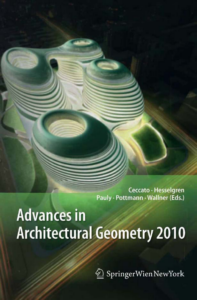Geometry lies at the core of the architectural design process. It is omnipresent, from the initial determination of form to the final construction. Modern geometric computing provides a variety of tools for the efficient design, analysis, and manufacturing of complex shapes. On the one hand this opens up new horizons for architecture. On the other, the architectural context also poses new problems for geometry. The research area of architectural geometry, situated at the border of applied geometry and architecture, is emerging to address these problems. This volume, presenting the papers accepted at the 2010 Advances in Architectural Geometry conference in Vienna, reflects the substantial progress made in this field. The interdisciplinary nature of architectural geometry is reflected in the diversity of backgrounds of the contributing authors. Renowned architects, engineers, mathematicians, and computer scientists present novel research ideas and cutting-edge solutions at the interface of geometry processing and architectural design.
Table of Contents
1. The Master-Builder-Geometer
2. Interpreting Physical Sketches as Architectural Models
1 Introduction
1.1 Tangible User Interface for Architectural Design
1.2 Contributions
1.3 Overview
2 Related Work
2.1 Modeling Interfaces for Architectural Design
2.2 Sketch Recognition
2.3 Sketch Recognition for Architectural Drawings
2.4 Gestalt Theory and Sketch Interpretation
3 Sketch Interpretation Algorithm
3.1 Image Pre-Processing
3.2 Intended Parallel, Perpendicular, and Collinear Elements
3.3 Linking Walls to Form Continuous Chains
3.4 Arrangement of Cells and Enclosure
3.5 Assigning Interior and Exterior Zones
3.6 Detecting Inferred Interior Walls and Trimming Unused Walls
3.7 Post-Processing: Constructing a Watertight Triangle Mesh
4 Validation of Physical Sketch Interpretation Environment
4.1 Design Collection Study
4.2 Re-Interpretation Study to Quantify Design Ambiguities
4.3 Validation Results: Subjective Feedback
4.4 Quantitative Sketch Interpretation Results
5 Conclusion and Future Work
References
3. Lamella Flock
1 Non-Linear Processes in Architectural Design
2 Zollinger – A Lamella Wood System
3 Free Form Wood Structures and Previous Experience
4 Investigating Freeform Lamella Systems
5 An Outline of Self-Organization
6 The generated lamella system, structure and behaviour
7 A hybrid system
8 Implementation
9 Conclusion
Acknowledgements
References
4. Case Studies in Cost-Optimized Paneling of Architectural Freeform Surfaces
1 Introduction
Related Work
2 Panels and Fabrication
3 Paneling Architectural Freeform Surfaces
3.1 Problem Specification
3.2 Paneling Algorithm
4 Extensions
4.1 Sharp Features
4.2 Adaptive Control of Paneling Quality
5 Case Studies
5.1 Facade Design Study
5.2 Skipper Library
5.3 Lissajous Tower
6 Discussion
Acknowledgments
References
5. Tiling Freeform Shapes With Straight Panels: Algorithmic Methods
1 Introduction
2 The Design of Patterns of Geodesics.
2.1 Design by Parallel Transport.
2.2 Design by Evolution and by Segmentation
3 Panels from Curve Patterns.
3.1 Panels with Pure Bending: the Tangent Developable Method.
3.2 The Binormal Method.
3.3 Discussion
4 Stress and Strain in Panels.
5 Conclusion.
References
6. Freeform Rigid-Foldable Structure Using Bidirectionally Flat-Foldable Planar Quadrilateral Mesh
1 Introduction
2 Geometry of Rigid-Foldable Quadrilateral Mesh Disk
2.1 Generalized Miura-ori
2.2 Generalized Eggbox Pattern
2.3 Hybrid Surface: Bidirectionally Flat-foldable Planar Quadrilateral Mesh
3 Design Variations of Rigid Foldable Surface
4 Rigid Foldable Cylinder
5 Materialization
6 Conclusion
References
7. The Sphere Project – Negotiate Geometrical Representations From Design to Production
1 Introduction
2 Geometry generation
2.1 Geometric principles
2.2 Fitness criteria for the evolutionary process
3 Geometry refinement for fabrication
4 Conclusion
Acknowledgements
8. Towards Teaching Generative Design in Architecture
1 Introduction
2 Towards Teaching
3 Three Conceptual Design Models
3.1 Model One
3.2 Model Two
3.3 Model Three
4 The Generative Design Seminar
4.1 Mathematic Form-Finding
4.2 Global Logics
4.3 Component Logics
5 Conclusion
References
9. Architectural Acoustics for Practioners
1 Introduction
2 Current Practice
3 Design of Raytracing tool
4 Tool in Action
4.1 Parametric Model
4.2 Analysis and Inspection
4.3 Visualization of Data
5 Conclusions
Acknowledgements
References
10. Wiggled Brick Bond
1 Introduction
2 The Pike Loop project
3 The wiggled bond
4 The primary layer
4.1 The distance map
4.2 The double exponent of interpolation
4.3 Solving the boundary condition for the primary layer on a curve
5 The Secondary Layer
5.1 The accentuation of the vertical lines
5.2 Resolving intersection by rotation around the outer corners
5.3 Resolving the remaining intersection on both layers
6 Conclusions
References
11. Geometric Methods and Computational Mechanics for the design of Stone Domes Based on Abeille’s Bond
1 Introduction
2 Definition of a geodesic dome
3 Construction of an Abeille’s bond
4 Mechanical computations
5 Fabrication information output
6 Conclusion
References
12. Louvre Abu Dhabi 1/33 – Fabrication of a Large-Scale Physical Light-Test Model
1 Introduction
2 STRUCTURE
2.1 Whole Dome
2.2 Building Parts
2.3 Modules
2.4 Bars and Knots
3 CLADDING
3.1 Cladding Data
3.2 Cladding Tile Production and Assembly
4 Conclusion
Acknowledgements
References
13. Ortho-Pictures: 3D Objects From Independent 2D Data Sets
1 Introduction
2 Background and Related Work
3 Constructing Ortho-Pictures
3.1 Vasarely style Ortho-Pictures
3.2 Ortho-Pictures from two 2D Images
3.3 Possible extensions
4 Conclusions
Acknowledgment
References
14. Geometry of Structural Form
1 Introduction
2 Graphic Statics and Reciprocal Diagrams
3 Geometry of an Efficient Truss
4 Invariants in Force-Flow and Structural Classification
5 Parametric Model of an Efficient Freeform Roof Structure
6 Conclusion and Future Work
Acknowledgements
References
15. Realizing Formal and Funcional Complexity for Structurally Dynamic Systems in Rapid Computational Means
1 Introduction
2 Topology – Material Distinction in Computation
3 From Anticlastic to Minimal Surface
4 Advanced Complexity – the Deep Surface
5 Conclusion
References
16. Statics-Sensitive Layout of Planar Quadrilateral Meshes
1 Introduction
1.1 Motivation
1.2 Outline of the Proposed Method
1.3 RelatedWork
2 Statics-Sensitive Preprocessing
2.1 Thin-Shell Model
2.2 Implementation Issues
3 PQ Meshing Step
3.1 Level Set Method and Quad Meshing
3.2 Planarization
4 Results
4.1 Great Court Roof of British Museum
4.2 Neumuenster Abbey Court Roof Study
5 Conclusion
Acknowledgments
References
List of Contributors
In Collection
#6870
Read It:
Yes
#6870
Read It:
Yes
Architecture
|
|
||||||
